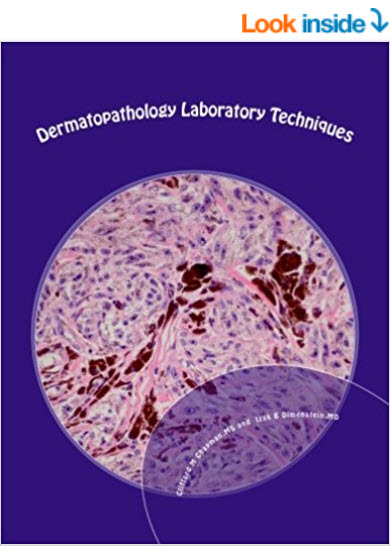Spill handling
Formalin spills are the real challenge. They are not so rare and require attention, training, and understanding. It makes sense to discuss this unfortunate situation in detail.
Formaldehyde gas evaporation depends on the square surface but not of the volume spilled fluid. Formalin in the 50 ml container is relatively harmless but the same amount that has been spread on the board or floor immediately irritates. The principle of handling the spill is to contain minimizing the surface of the spill.
Every institution has their policies and protocols regarding handling chemical hazards spills. This article provides the author’s approach to handling specifically formalin spills based on personal experience and physical and chemical features described in formalin/formaldehyde background section.
An article about laboratory safety had a section titled: “What To Do if Formaldehyde Is Spilled”.In histology laboratory formalin is spilled. This distinction is substantial for cleaning actions when the goal is to prevent evaporation of formaldehyde from its water solution, namely formalin.
How much formalin constitutes a spill as far as safety is concerned? OSHA has an “informative” definition as “appreciable quantity”. For example, OSHA recommends “if a spill of appreciable quantity occurs, leave the area quickly unless you have specific emergency duties” to wait for designated person to stop the leak. This is, probably, for industrial situations.
Histology laboratory rarely manipulates at the same time quantities more than one gallon (3.8 liters). Usually, spills which can be a safety concern range from 50 ml to 2 liters. Of course, there is a difference where the spill occurs: on the grossing station’s table or on the laboratory floor.
Who supposed to handle formalin spill? To call or not to call for outside help in case of large spill? What constitutes a large spill for histology laboratory?
If the institutional policies definitely determine the amount of the spilled formalin that requires Hazardous Materials Response Department involvement, of course, the call is obligatory to be in compliance. However, often it is useless and even contra productive. Deficit of time is a substantial factor. As a rule spills are not planned but occur suddenly. Hopefully, there is a spill kit in every laboratory that uses formalin.
The working rooms where spills occur are not empty and completely flat floor surfaces. Formalin should be containing as much as possible otherwise it spreads everywhere, including under the tables and equipment with gradual evaporation. The clean up in the laboratory should start immediately with or without call for outside help.
First and foremost an appropriate PPE as disposable gown, gloves, safety glasses (nonvented goggles are difficult to handle while cleaning), and a wet mask, preferably Kimberly-Clark Face Shield type. The wet mask is reasonable because the evaporating formaldehyde goes through even the multi layers of dry mask, but a wet mask partially absorbs formaldehyde due to high solubility in water. What about a full-face respirator with formaldehyde-absorbing cartridges, as is usually recommended? Yes, if it is on hand, fit the face, and a person is trained to use it. In practice all three conditions are not in place.
The spill should be contained by building around a dike like wall of wet paper/cloth to absorb formalin as much as possible preventing formaldehyde from evaporation from thin layer of formalin on the floor. The absorbing material is moved from the periphery to the center. The soaked paper/cloth should be collected in sealable plastic waste bags that are placed in a closed container and replaced by dry paper/cloth. While moving the wet paper/cloth towels to the center, the floor can be covered by a neutralizer, like Spill-X-FP), if it is on hand. Absorption and polymerization requires some time, at least 10-15 minutes.
Simultaneously it is necessary to enhance ventilation as the grossing stations and other areas, as well as open running water facets to increase humidity in the room that diminish evaporation. It is reasonable to change many times the wet face mask because it becomes saturated with formalin. In this situation the wet mask becomes also an obstacle to breath under conditions of intensive physical labor during cleaning up operation.
If the outside help cleaning team arrives, it will not be in a moment anyway, let them finish the job according to institutional policies. If the outside help team is not involved, make sure to put neutralizer into containers with clean up materials soaked with formalin. Anyway, the entire area of the cleanup up requires a moping with generous amount of soup water.
It would not a bad idea to take care of the participants of the spills clean up. Of course, if somebody feels not well, medical help must be provided. In an acute exposure, when the dose of formaldehyde excises the absorption and dilution by nose cavity mucus layer, most people feel irritation of the throat first. This is especially true under conditions of emergency intensive work and communications. Milk or alkaline drinks, for people who cannot tolerate milk, is optimal for immediate drinking, keeping in mouth, and gargling.
Some years ago, late in the evening my coworker dropped on the floor a bucket with cassettes collected for processing and around 2 liters of formalin. In agitation of collecting of the dispersed around cassettes and cleaning up formalin, we violated every rule of safety. As a result, I had a painful sore throat and lost my voice for almost a week.
Table 1 summarizes individual action, engineering measures and personal protective equipment in formalin spill
Table 1
Formalin spill management
| Individual actions | Engineering measures | Personal Protective Equipment |
| Contain to minimize evaporation | Intensify local and general ventilation | Gown disposable |
| Absorb in wet paper/fabric towels | Humidify the space of the room | Safety glasses/ goggles |
| Dilute with water | Wet mask (many changes during procedure) | |
| Eliminate absorbed formalin towels in closed bags | Gloves (nitrile better than latex) | |
| Neutralize absorbed formalin | Respirator if individually tested before the accident | |
| Mop the floor | Water resisted shoes |
Formalin spills often are accompanied by splashes that are another safety concern in the laboratory and require a different sat of precaution.
Splashes
Of course, splashes occur without spills also. They are always a result of poor working practices or negligence.
Just as a final confession, I had formalin splashes twice (silly, isn’t it?) many years ago when the pathologists grossed by themselves and the specimens arrive in the laboratory from surgery always in formalin. While opening ovarian cysts, the formalin fixed content burst during cut. Intolerable pain, treatment in emergency, and some time of persistent sore in the eye were the punishment for working without glasses. Clouded vision lasted for a week. This happened before the time of eye washing station, and before my understanding how to handle such injury. Since then, the first thing for me, while entering the histology laboratory, is safety glasses on.
Safety glasses with above and side shields completely protect from splashes. Some recent models though are fashionable but unreliable because the modern design leaves to mush open space for formalin splashes. Goggles are unpractical for every day work because they are uncomfortable, irritation periorbital skin, and… really ridiculous. A shield mask, like Kimberly-Clark does not provide a reliable protection and it is inconvenient for long work. Personal glasses obviously cannot be substituted for safety glasses that require wearing them both.
Eye washing after a formalin splash is obligatory, and every histology laboratory has an eyewash station. However, 15 minutes recommendation is not only practically unsustainable but wrong. It is completely enough to wash a couple minutes. The tap water is obviously not sterile; it contains chemical sub stances which irritate the sclera and conjunctiva. Formaldehyde cannot penetrate deep. Though uncomfortable, the water should be cold because warm formalin remnants penetrate faster but the goal is the opposite. It is more reasonable to allow the sterile tears to wash away the remnants of formalin. An onion, which emanates bactericidal ethers, can provide healing tears in abundance instead of irritation by tap water. Though this sounds not seriously enough, I wish I had in my accidents an onion, which emanates bactericidal ethers, can provide healing tears in abundance instead of irritation by tap water. Medical help would be highly recommended if the person were uncomfortable after eye rinsing.
Scigen (Scigenus.com) offers Neutra-Pads® Grossing and Formalin Spil l Pads. Each pad neutralizes 80 mls of 10% formalin. Neutra-Pads® encapsulate and neutralize formalin during grossing. The pad features aplastic barrier. Formalin Spill Control Pads Neutra-Pads® can also be used to neutralize formalin spills in storage areas. There is also a product Neutra-Form® Spill Control Agent, as well as Neutra-Wipes® Absorbent Wipes (each wipe neutralizes 30 to 50 mls of 10% formalin.)








